Stone Mountain, Georgia: The History, Monument, Controversy, and Commemorative Stamp
Stone Mountain is the name of a dome-shaped mineral outcrop called a monadnock or a pluton, "the largest exposed mass of granite in the world," according to David B. Freeman, author of Carved in Stone: The History of Stone Mountain.
It rises 780 feet from the surrounding area, is seven miles in circumference, covers 563 acres, and gives its name to a small town at the base of the rock, located about 16 miles east of Atlanta, Ga.
Today Stone Mountain is best known as a tourist attraction that draws about four million visitors each year, lured by a carving on the bald battleship-gray vertical north face of the mountain that is the world's largest bas-relief sculpture, and from the poetic crescendo of Rev. Martin Luther King's Aug. 28, 1963, "I Have a Dream" speech:
Let freedom ring from Stone Mountain of Georgia.
Let freedom ring from Lookout Mountain of Tennessee.
Let freedom ring from every hill and molehill of Mississippi.
From every mountainside, let freedom ring.
Georgia has designated the sculpture and surrounding park as a monument to the Confederate States of America (CSA), which seceded from the United States and launched the 1861-1865 Civil War in a failed attempt to preserve the institution of forced, uncompensated labor based on the lifetime enslavement of Africans, their offspring, and their descendants.
Equestrian images of Jefferson Davis, president of the Confederacy, and two Confederate generals, Robert E. Lee and Thomas "Stonewall" Jackson, are carved on the mountainside.
History of Stone Mountain
Indigenous Americans had inhabited the area for millennia, and had encircled the mountaintop with a rock wall long before the first European explorers arrived.
In 1597, Spanish settlers along the Georgia coast heard stories about its striking appearance. By the end of the following century, English traders had been there. A sad consequence was an epidemic of alien diseases that decimated local tribes. In the 18th century, survivors formed the Creek Confederation to oppose further European incursion, with Stone Mountain as their ceremonial meeting ground, at the crossroads of trails to and from settlements throughout the region.
The 1821 Treaty of Indian Springs opened the area to settlement by outsiders. Elected president in 1828, Andrew Jackson called for removal of eastern tribes to the West. Congress passed the Indian Removal Act in 1830; federal troops expelled the Creeks and Cherokees from Georgia in the Trail of Tears forced march during 1838 and 1839.
Meanwhile the government had established the Rock Mountain post office July 18, 1834, and renamed it Stone Mountain in January 1836. The village at the base of the mountain was incorporated as New Gibraltar on Dec. 21, 1839. In 1845, it moved half a mile west, and assumed its present name in 1847. Railroad connections with Atlanta and Augusta brought prosperity. By 1850, the scenic town had become a resort for city-dwellers on holidays as well as a hub for shipping farm produce and quarried granite to market.
The 1860 census reported 164 white households and 290 slaves in the Stone Mountain area. Although a majority of DeKalb County voters opposed secession, local men enlisted in the Confederate Army shortly after war against the Union erupted April 12, 1861, at Fort Sumter, S.C.

Confederate artillerymen used Stone Mountain as a target to test breech-loading cannon manufactured in Atlanta for accuracy. In the summer of 1864, federal troops, commanded by Gen. James B. McPherson, routed Rebel forces at Stone Mountain and destroyed the railroad line while the main body of Gen. William Tecumseh Sherman's army laid siege to Atlanta.

Atlanta surrendered Sept. 2; its capture assured the re-election of Abraham Lincoln. Sherman next deployed his forces for his march to the sea, which began Nov. 15, 1864. On the first day of the march, his left flank reached Stone Mountain and camped there. The 2nd Massachusetts Volunteers destroyed public buildings in the town before resuming their advance.
As Sherman's army swept across Georgia, thousands of slaves left their former owners and followed the Union Army to Savannah in the largest mass liberation since the Vicksburg campaign of 1863. On Jan. 16, 1865, Sherman issued Special Field Orders No. 15, which confiscated 400,000 acres of South Carolina, Georgia, and Florida land along the Atlantic coast and divided it into parcels settled and worked by freed former slaves, each family given 40 acres and a mule.
After Lincoln was assassinated in April 1865, President Andrew Johnson revoked Sherman's order, but grateful African-Americans at Stone Mountain named their community Sherman Town in his honor, as it has been known ever since. Local businesses prospered after the war, and by 1871 they promoted their restored resort as "America's favorite picnic ground."
In 1886, a firm owned by George Morelin, Charles Horne, Samuel H. Venable, and William H. Venable purchased the Stone Mountain Granite and Railway Co.
Soon afterward, the Venable brothers bought out Morelin's and Horne's shares. William Venable died in 1905, leaving Samuel as the most important property owner when William J. Simmons founded the second Ku Klux Klan and burned a cross at the top of Stone Mountain on Thanksgiving Day, Nov. 25, 1915.
In his book Lies Across America: What Our Historic Sites Get Wrong, my friend and colleague James W. Loewen wrote:
Simmons gathered 34 white men there who called themselves the "Knights of Mary Phagan." Phagan, a young white factory worker, had been murdered in Atlanta two years earlier. Leo Frank, a Jewish industrialist, was (erroneously) convicted of the crime. In August 1915, a band of whites took him from prison and hanged him. Spurred by their success and inspired by the recently released film Birth of a Nation, which told a tale of purported Reconstruction horrors, the men, some of whom had participated in lynching Frank, met on top of Stone Mountain to form the second national Klan.
Simmons had timed his inaugural rally to coincide with the Atlanta opening of Birth of a Nation. D.W. Griffith's silent motion picture glorified the original KKK, which had terrorized and murdered black and white Republicans in the former Confederacy from 1865 to 1877, and had ruthlessly restored white-supremacist governments to those states by preventing freed former slaves and their allies from voting. The movie portrayed African-Americans, played mostly by white actors in blackface makeup, as sex-crazed savage brutes who defiled white women.
Venable became a member of the Klan and hosted KKK events on his mountain for decades afterward. In 1923, he granted the Atlanta Klavern of the Ku Klux Klan an easement to hold annual rallies at the top of Stone Mountain. Samuel Venable never married; he died in 1939. The easement to the Klan remained in effect until the state of Georgia purchased the property from Venable's heirs in 1958.
In 1963, James R. Venable, nephew of the former owner, became imperial wizard of the National Knights of the Ku Klux Klan, the third iteration of the KKK, this time aimed at terrorizing and suppressing the growing civil-rights movement for racial equality. Loewen wrote, "Every Labor Day weekend, Venable, who for a time was mayor of Stone Mountain, invited the Klan to his property at the base of the mountain for rallies that included burning three 60-foot crosses." James Venable died in 1993.
In 1997, Stone Mountain city councilman Charles E. Burris became the first African-American mayor of the town. He defeated incumbent Patricia Wheeler 278 votes to 260.
At the time of his election, Burris and his family lived in the home that had been James Venable's residence. "Tell me that God doesn't have a sense of humor," Burris remarked to the New York Times after the election. Burris died in 2009 at age 57; Wheeler is once again the mayor.
Envisioning a Monument to the Confederacy
In 1914, two editorial writers had called for likenesses of Confederate leaders to be placed on the face of Stone Mountain. Caroline Helen Jemison Plane, widow of a Confederate officer killed in the war, a member of United Daughters of the Confederacy and first president of the UDC's Georgia division, took up the cause and became its prime advocate.
The Georgia division and Atlanta chapter of UDC approved her proposal for a 70-foot bust of Robert E. Lee on the mountain. Venable agreed to allow the carving. In June 1915, Plane invited Idaho-born artist Gutzon Borglum to visit Atlanta and consider taking the assignment; he arrived in August to examine the site.

Borglum told Plane that a single bust of Lee would be insignificant and not a suitable tribute, "a postage stamp on a barn door." He submitted an alternative proposal that would feature Davis, Lee, Jackson, and four other top CSA commanders as the central panorama, followed by their armies, including 65 additional individual likenesses, plus horses and artillery, together with a large memorial hall at the foot of Stone Mountain, an amphitheater on the right and an artificial lake on the left.
Plane suggested adding a Ku Klux Klan group, "which saved us from Negro domination and carpetbag rule . . in their nightly uniforms approaching in the distance," to Borglum's 72 figures. Borglum did not accept her idea but he included an altar to the Klan in his plan. He joined the secret order and became active in its top ranks. Borglum began work in 1923, the same year that Venable granted the KKK's easement to convene on the mountain.
On Jan. 19, 1924, with only Lee's roughly carved image to be viewed, 5,000 people attended an unveiling ceremony at Stone Mountain. On March 17, Congress passed and President Calvin Coolidge signed the Stone Mountain Memorial Coinage Act, which authorized the United States Mint to issue up to five million commemorative half dollars, to be sold at face value to the Stone Mountain Confederate Monumental Association, which in turn would sell them to the public at a profit and use the proceeds to pay the costs of the project.
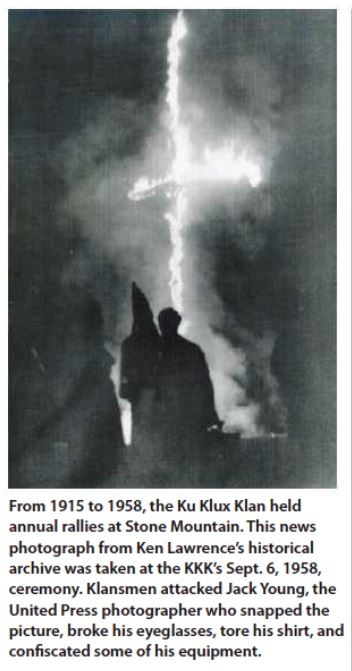
Not long afterward relations between Borglum and his employers began to deteriorate. On Feb. 25, 1925, the association accused the artist of "neglect and virtual abandonment, inordinate demands for money not due him, offensive egotism, and delusions of grandeur," and fired him. Outraged by the executive committee's action, Borglum smashed his models. Officers of the association filed charges of malicious mischief and willful destruction of association property against him.
Borglum barely escaped arrest as he fled the state, never again to be involved with the Stone Mountain sculpture. After leaving Georgia, Borglum relocated to the Black Hills of South Dakota where he carved the Mount Rushmore National Memorial.
A New Artist and a Fresh Design for Stone Mountain
After dismissing Borglum, the association's officers searched for another sculptor to resume the project. Their first choice was Lorado Taft, but he refused because "no self-respecting artist would take over another man's work." After being rejected by several other well-known sculptors, the association commissioned Henry Augustus Lukeman of New York on April 17, 1926. Helen Plane, age 96, died a week later; sponsorship had passed to a new team.
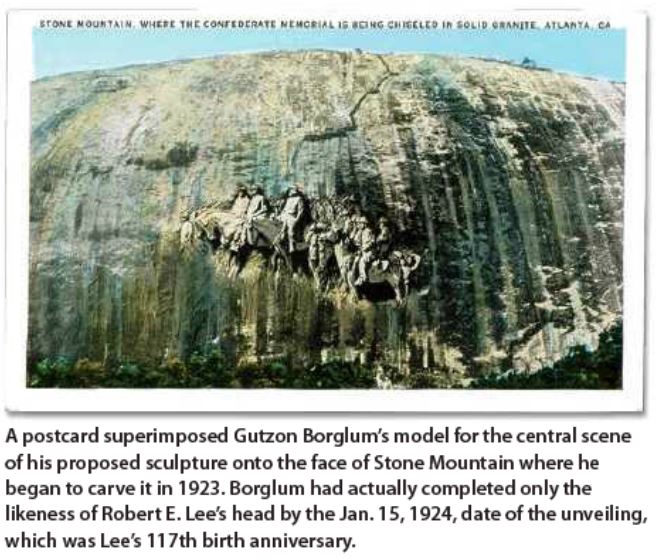
Ironically, the commemorative coins that featured Borglum's images of Lee and Jackson were minted just as his successor was crafting a new model. Instead of 72 figures, Lukeman proposed just nine, still in a procession led by Davis, Lee, and Jackson but in formal heroic postures, not the naturalistic poses favored by Borglum.
After securing the association's approval, Lukeman and his carving team set to work in September 1926, first by blasting a new vertical face into the mountain with dynamite, removing more than one million cubic feet of rock that weighed more than 85,000 tons, which all but obliterated Borglum's version of Lee. Lukeman's Lee was unveiled April 9, 1928, the 63rd anniversary of the general's surrender at Appomattox.
That was as far as Lukeman got. The unveiling was a disappointment. Coin sales had failed to generate the anticipated income, partly because they had been condemned by the Union veterans' Grand Army of the Republic organization and partly because Borglum and his supporters resented his humiliation and refused to help his successor. Only 1,314,709 were purchased. With funds almost gone, the association ordered work on the sculpture halted at the end of May 1928. Title to the property reverted to Venable, and after his death to his descendants. Lukeman died in 1935; Borglum, in 1941.
Using Confederate Symbols to Oppose Civil Rights
After the U.S. Supreme Court ordered the desegregation of public schools in its 1955 Brown v. Board of Education decision, white demagogues responded with racist pledges to defy federal law and to thwart the movement for civil rights. In that poisoned political discourse, white legislators embraced Confederate emblems as symbols of their opposition to equal rights for African-Americans.
In 1956, the Georgia legislature replaced horizontal red and white stripes on the state flag with the Confederate battle flag that featured a St. Andrew's cross as its most recognizable feature. In 1958 the state of Georgia purchased the Stone Mountain property, determined to complete the Confederate memorial.
Among the first additions were "white" and "colored" racially segregated comfort stations. In 1962, the association selected a third sculptor, Walker Kirtland Hancock of Massachusetts, to finish the job. Once again the design changed, becoming smaller and including fewer figures.
Hancock's plan eliminated the horses' legs that had featured so prominently in Lukeman's model "to give the emphasis to essential features while avoiding a stark realism where it would be inappropriate." More candidly it meant less toil for the artist and his team of rock carvers, and lent an unfinished aura to the result.
Rock carving technology had made great strides during the 35 years that the sculpture had been neglected. The new tool of choice, the thermal-jet torch, not only allowed for more intricately detailed and accurate cuts; it was also far more efficient. One carver "could remove as much stone in a day as twenty men could do in a week with pneumatic drills and wedges," according to Freeman.
Work officially resumed July 11, 1964, and six years later the job was nearly finished. A dedication ceremony for the monument was held May 9, 1970. President Richard Nixon had agreed to be the keynote speaker, but "the crisis in Cambodia and student unrest at home forced Mr. Nixon to cancel his visit," according to the New York Times.
Vice President Spiro Agnew spoke in his place. The Washington Star reported, "A memorial official described the turnout as disappointing, but there were indications that the crowd was more disappointed with the vice president's speech." Instead of a speech about Confederate glory, he called for national unity in support of the U.S. war in Indochina.
The organizers had expected a crowd of 100,000 to attend, but fewer than 10,000 official guests and spectators actually came. "Wishbone Chicken Company sold only 2,000 of 10,000 boxes of fried chicken prepared for the event," noted Freeman. A Washington Post reporter caught the mood of those who had attended: ". the mountain is a symbol of the Klan to some, to others it is a monument to the lost cause and the Confederate dead of the Civil War."
The KKK and the Lost Cause had evidently lost some of their luster, but that did not prompt anyone to reconsider whether a postal commemoration, which had been wending its way through phases of planning and execution since 1968, was appropriate.
Postal Commemorations of Confederate Leaders
Every U.S. postage stamp issued to commemorate Confederate leaders has generated controversy. First was the 4¢ Robert E. Lee, Thomas J. Jackson, and Stratford Hall (Lee's birthplace) stamp in the 1937 Army set, Scott 788. As soon as the plan to issue the stamp was announced in June 1936, Union veterans gathered at the Grand Army of the Republic national encampment denounced it.
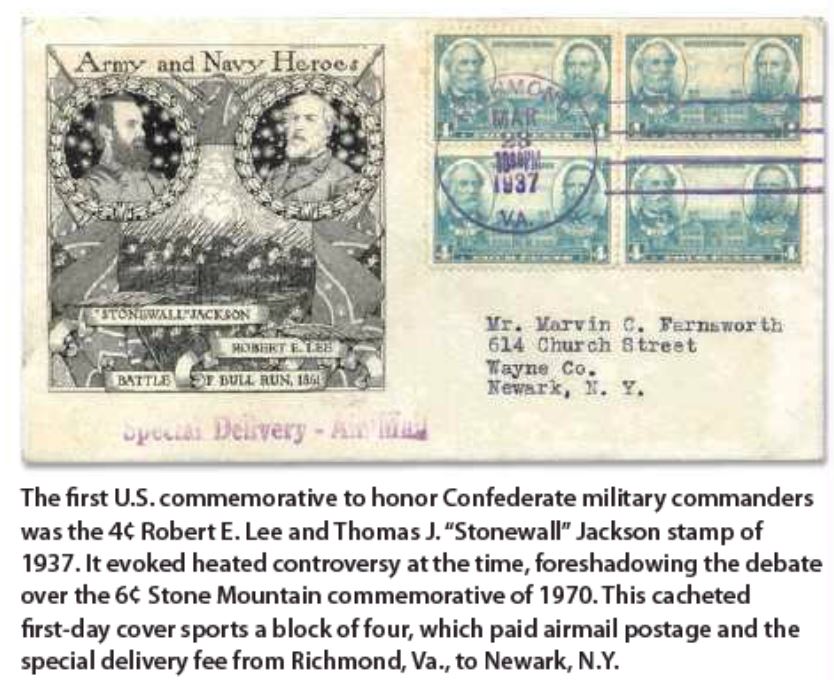
Oddly, Lost Cause adherents attacked the stamp after it was issued because Lee was depicted with only two stars on his collar, not the three that he had worn as the top commander. But the design had been adapted from a drawing submitted by no less a Confederate expert than August Dietz, the dean of CSA philately.
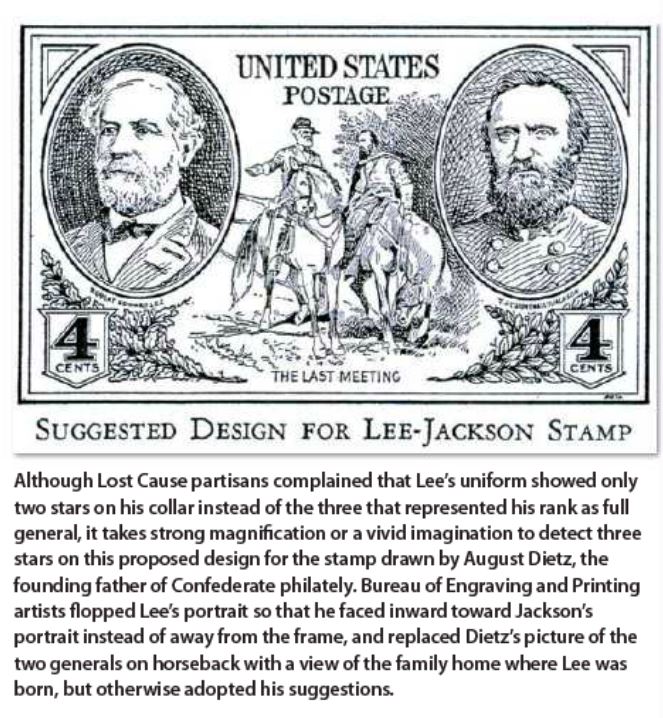
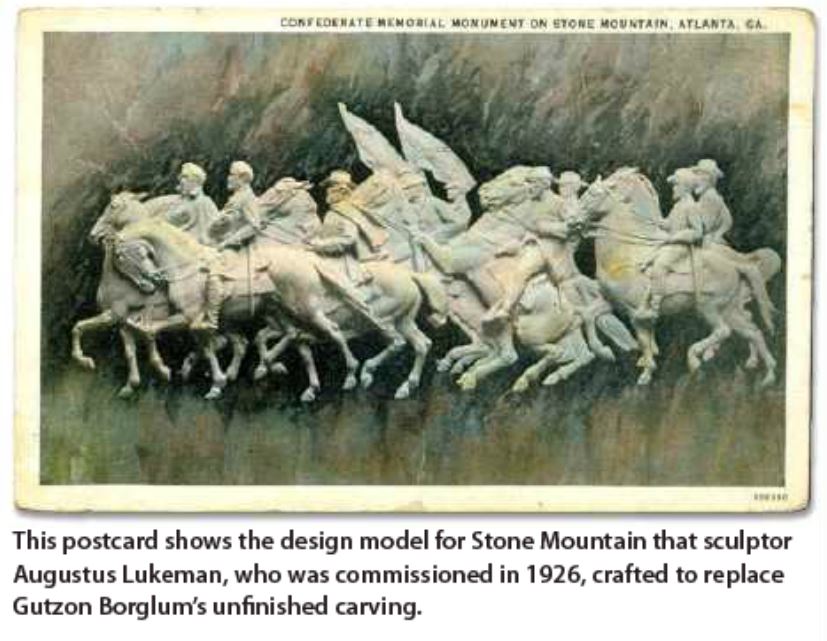
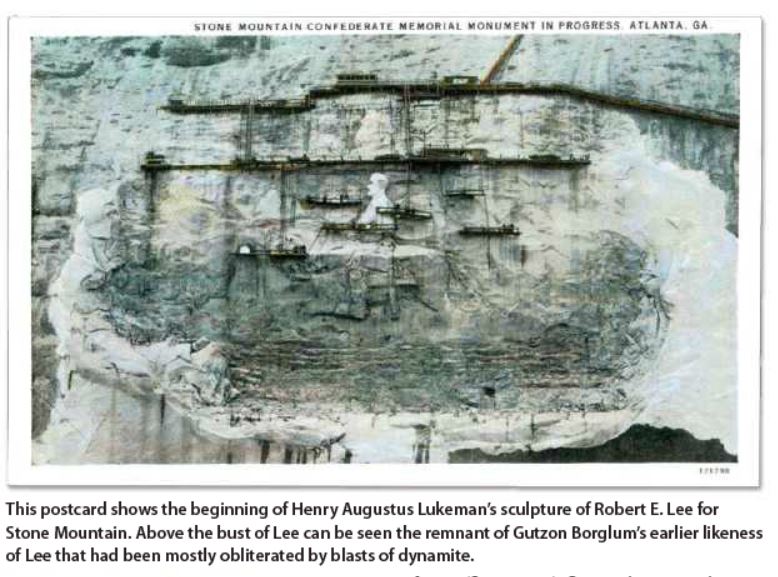
The 3¢ United Confederate Veterans stamp of 1951 (Scott 998) was more pathetic than offensive, issued on the occasion when three of the last 12 surviving veterans of the Confederate Army gathered for their final meeting at Norfolk, Va.
The U.S. Navy performed a reenactment of the battle between the Monitor and the Merrimac, where the Union's ironclad won. The Post Office Department used exactly the same portraits for the United Confederate Veterans stamp that had been pictured on the 3¢ Grand Army of the Republic stamp issued in 1949 (Scott 985) on the occasion of the GAR's final encampment in Indiana, changing only the color, inscription, and insignia. Critics on both sides were insulted by the similarity.
When the Post Office Department issued the 30¢ Robert E. Lee stamp of the Liberty series in 1955 (Scott 1049) Lee was portrayed in civilian clothes even though the photograph used as the model had pictured him in his Confederate uniform. Nevertheless, letters to newspapers throughout the country argued that Lee had betrayed his country and was unfit as a stamp subject, quickly followed by letters expressing the opposite opinion.
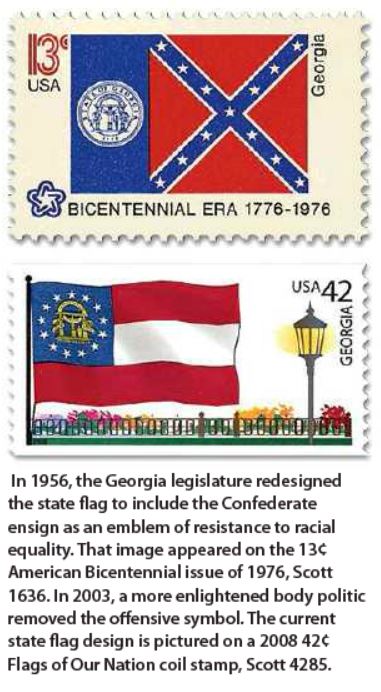
After the Postal Service issued the Civil War Legends pane of 20 32¢ stamps (Scott 2975), I wrote in my August 1995 American Philatelist column that "subjects on the Civil War pane honor equally those who committed armed treason in defense of chattel slavery with those who stood and fought gallantly for freedom." It was a passing but opinionated phrase in an article about the variety of stamp subjects offered that year.
Prof. James T. Currie of Virginia protested in the October issue, "I have enjoyed reading Ken Lawrence's columns until now. I knew Ken twenty years ago in Mississippi and accept his political persuasion, which is somewhat to the left of center . His statement . goes too far. It is obvious that Ken should stick to stamps and leave history and political commentary to others." Another 20 years on and here I am, still at it.
The 6¢ Stone Mountain Commemorative of 1970
My objection to the 1995 Civil War Legends pane pales in comparison to my low regard for the 6¢ Stone Mountain Memorial stamp of 1970 (Scott 1408). On previous occasions, under both Democratic and Republican administrations, the Post Office Department had steadfastly refused to honor Davis on a postal issue, even after accepting Lee and Jackson as stamp subjects.
For example, on May 18, 1960, the Associated Press reported that the Citizens' Stamp Advisory Committee "unanimously agreed not to recommend issuing a Jefferson Davis commemorative stamp in 1961" as part of the Civil War centennial issue.
Anticipating the Stone Mountain stamp "to reflect Federal forgiveness," stamp columnist David Lidman wrote in the Aug. 23, 1970, New York Times, "Lee and Jackson have appeared on other United States stamps, but Davis never."
Belmont Faries, the Washington Evening Star editor who later chaired the CSAC, gave an uncharacteristically blunt account in the May 1973 S.P.A. Journal:
The Stone Mountain Memorial commemorative of 1970 reflects, to an unusual degree, the role of complex political pressures and sectional prejudices in the selection of stamp subjects. .
An item "Stone Mountain, Ga. Sculpture - completion and unveiling in May 1969" appeared on the agenda of the Stamp Advisory Committee at its meeting of May 21, 1968. No action was taken. The committee had consistently since its creation refused to approve a stamp for Jefferson Davis and had little enthusiasm for promoting a Confederate memorial at a time when civil rights was a major political issue.
By early 1969, when the delayed dedication had been fixed as May or June 1970, the political situation had changed. A carefully cultivated "Southern strategy" had contributed to the election of a Republican president, Richard Nixon, and the new postmaster general was a Republican from Alabama, Winton M. Blount. Rep. [Ben B.] Blackburn, a Republican, made a new request for a stamp in April, 1969. .
At its meeting of Sept. 10, 1969, Postmaster General Blount's new Citizens' Stamp Advisory Committee had recommended a Stone Mountain Memorial stamp. It repeated the recommendation on Feb. 6, 1970. .
The Stone Mountain stamp drew quite a bit of criticism in Congress and in letters to newspapers and the Post Office Department. An American Federation of Teachers local in Philadelphia was irritated that a stamp could be issued for Confederate leaders while there was none for Dr. Martin Luther King. A letter-to-the-editor writer, obviously an unreconstructed Northerner, wanted to know if a Benedict Arnold stamp would be next. .
In any event it had served its purpose - it had helped build the image of a Republican Administration sympathetic to the South. .
Georgia Gov. Lester Maddox, hosted the Sept. 19, 1970, dedication ceremony. Maddox was a segregationist firebrand who had become famous for his refusal to allow African-Americans to dine at his Pickrick Restaurant in Atlanta. He had distributed axe handles to his racist supporters as clubs to intimidate and beat black people who tried to enter his establishment.
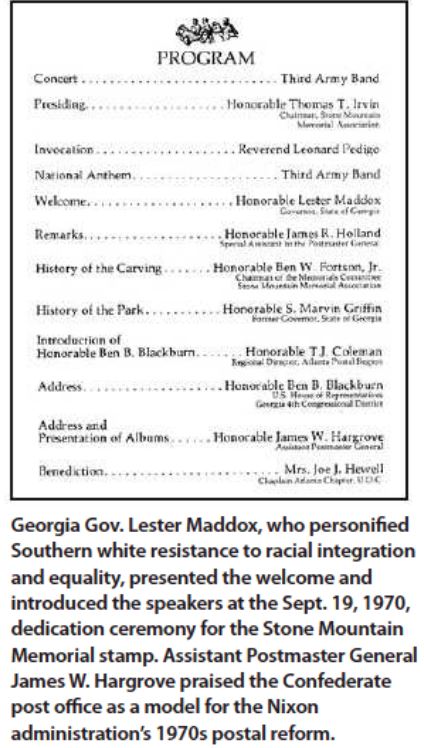
On July 3, 1964, just a week before Hancock's rock carvers resumed work on Stone Mountain, Maddox became the first business owner to publicly, deliberately violate the federal Civil Rights Act that had outlawed racial discrimination in public accommodations. When a federal court ordered him to admit black customers, Maddox sold the restaurant so he would not have to obey and launched a career in politics as a die-hard white-supremacist.

At the 1970 dedication ceremony, Maddox performed as a Lost Cause spokesman with choice words for Gen. Sherman, reminding the crowd who had burned Atlanta. But Assistant Postmaster General James W. Hargrove presented even more enthusiastic praise for the Confederacy. He likened the Nixon administration's postal reforms to the example pioneered by the CSA post office headed by John H. Reagan, Davis's postmaster general:
Comparisons are always risky, but our efforts at postal reform in 1970 are not too far off the course which Reagan tried to follow 109 years ago." (On July 1, 1971, the Post Office Department ceased to exist, replaced by the business-oriented U.S. Postal Service and the U.S. postmaster general ceased to be a member of the president's cabinet.) In reality, Confederate postal service had been less efficient and more expensive than U.S. mail of the 1860s.
Naturally I collect the Stone Mountain stamp despite my revulsion, but there's not a lot to recommend it. The Scott catalog lists no errors or varieties; as a dull gray monochrome design it hasn't attracted much interest from collectors, but my collection includes the illustrated example that caught my eye as a United States stamp specialist, with misregistered perforations that affected the appearance.
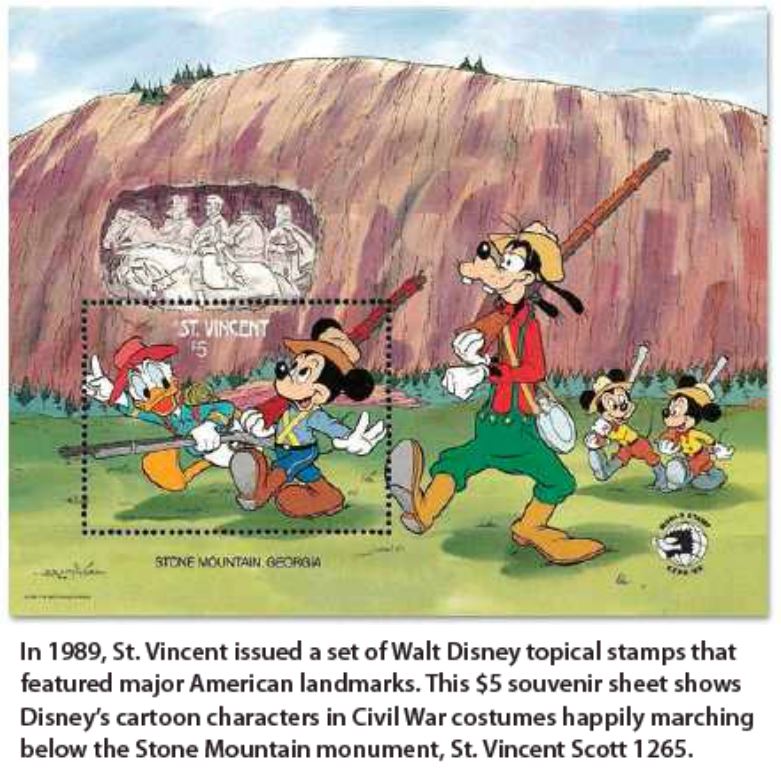
A second Stone Mountain stamp, a $5 souvenir sheet issued by St. Vincent in 1989, which shows Walt Disney cartoon characters as Civil War reenactors in front of Stone Mountain, is more colorful, and does not annoy me as much as the 1970 U.S. stamp does.
When Lester Maddox died in 2003 at age 87, the New York Times called him "one of the last of the Southern demagogues." Today officials who manage the Stone Mountain Memorial are scrambling to shed the racist trappings that have been so essential to the park's purpose, but their changes might be too little and too late to satisfy 21st century standards of fairness, respect for fellow citizens, and civic dignity.
The American Custom of Toppling Monuments
The tradition of toppling monuments and tearing down symbols of oppressors, foes, and false gods is almost as ancient as the tradition of erecting them. It's as American as fireworks on the Fourth of July, almost literally.
On July 9, 1776, immediately after the Declaration of Independence was read at New York to George Washington's army, a group of soldiers and local citizens went to Bowling Green Park in Manhattan where they pulled down and dismembered a large gilded monument of King George III on horseback.
Lead from the statue was melted down into 42,088 musket balls, which the Continental Army used as ammunition in the Revolutionary War. One might accuse that mob of having rewritten history, but if they did, it wasn't by erasing the memory of a despised despot from history books or from lessons taught to later generations of school children, even though visitors to Bowling Green Park are no longer able to play in the shadow of a toga-clad tyrant.
Anyone who wishes to celebrate or mourn the memory of George III, including descendants of colonial American Tories and their Hessian mercenaries, is free to do so. But no one should have the power to impose the king's image as a lesson model for Americans. Such an attempt would rightfully be condemned as myth-making, not praised as honoring history.
With respect to Confederate symbols, the issue is not simply one of respecting the dead, as in a cemetery, or their notable achievements, as in a museum display. In the late 19th and early 20th centuries, these images were placed in government buildings and public spaces as affirmations that white supremacy had been restored after the overthrow of Reconstruction-era interracial Republican governments.
Last summer, after a deranged white racist named Dylann Roof, who embraced the Confederate battle flag as the emblem of his doctrine, murdered nine African-Americans at the Emanuel African Methodist Episcopal Church in Charleston, S.C., and shocked the conscience of the community, the push to remove symbols that incited race hatred from public places gained momentum.
This was not a new issue in Georgia. The Confederate battle flag had been incorporated into the design of the Georgia state flag in 1956 as a gesture of segregationist defiance to racial integration. After decades of debate and a few failed attempts at compromise, the legislature finally voted to remove the offensive emblem in May 2003, and Gov. Sonny Perdue signed the bill into law.
Debating the Future of Stone Mountain
Less than a month after the Charleston massacre, critics of public Confederate iconography directed their attention toward the biggest example of all, the one that has been entwined with the Ku Klux Klan for 100 years. In July the Atlanta NAACP demanded that relief sculptures be removed from the face of Stone Mountain, calling them a "glorification of white supremacy."
An unnamed spokesman for the memorial responded that the issue was up to the legislature. The proposal to remove the large likenesses of Davis, Lee, and Jackson from Stone Mountain is not radical; precedent already exists for demolishing Lee's first Stone Mountain image. Skilled stone workers could take down the current version just as easily, but it would be costly and would surely affect attendance.
Hoping to defuse the issue without a loss of revenue, Bill Stephens, the chief executive officer of the Stone Mountain Memorial Association, announced last October that the park will erect a tower on the top of the mountain containing a replica of the Liberty Bell as a tribute to the Rev. King and the line from his "I Have a Dream" speech. Gov. Nathan Deal at first endorsed the plan, but it has subsequently become mired in controversy.
Georgia law requires that "the memorial to the heroes of the Confederate States of America graven upon the face of Stone Mountain shall never be altered, removed, concealed or obscured in any fashion and shall be preserved and protected for all time as a tribute to the bravery and heroism of the citizens of the state who suffered and died in their cause." Adherents of the Lost Cause recite that provision to deflect every proposal for change.
But the hypocrisy and duplicity of the Lost Cause club is transparent to anyone who takes more than a superficial look. For evidence, consider the case of Lt. Gen. James Longstreet, a senior Confederate commander whom Lee affectionately called "my old war horse." If the purpose of Stone Mountain and other shrines is to honor historical truth, Longstreet would be featured alongside Lee, and in Georgia, at least, Jackson probably would not.
Longstreet's image isn't there because neo-Confederates detest his memory so thoroughly that there was no monument to him at all until 1998, when the National Park Service placed an equestrian statue of him at the Gettysburg National Military Park.
The reason is straightforward and exposes an inconvenient truth. Longstreet was the only senior Confederate general to join the Republican Party during Reconstruction. He supported Gen. Ulysses S. Grant for president and embraced equal rights for African-Americans. (There is a Longstreet museum in Russellville, Tenn., the location of his 1863 winter headquarters.)
Yet Longstreet has a stronger connection to Georgia than any of the three who are represented. The legal phrase that designates Stone Mountain as a "tribute to the bravery and heroism of the citizens of the state" is an odd requirement. None of the three men were citizens of Georgia, and of the three, neither Lee nor Jackson had any significant link to the state.
Other Possible Lesson Plans for Stone Mountain
I favor eradication of Davis, Lee, and Jackson, but politically that will probably prove difficult to achieve any time soon. Meanwhile, a more immediately practical plan might be to modify parts of the existing sculpture or to add new carvings, or both. There's a lot of vacant rock on that mountainside.
Of the three, Jackson has the least plausible claim to represent citizens of Georgia, but it might be possible to replace Jackson's head and shoulders with a bust of Longstreet, or to add Longstreet and his mount as a fourth figure in the procession if removing Jackson isn't feasible.
Including Longstreet would provide a plausible reason for Lee to be present as Longstreet's commander. Together they would provide an excellent tableau for educating visitors about the choices that faced former Confederate soldiers and citizens after the war, with Longstreet welcoming emancipation and black suffrage while Lee remained largely equivocal and unrepentant.
Longstreet became a model citizen of Georgia, a man whom young Georgians could properly learn to admire. In 1875 he moved his family to Gainesville, where he served for a time as postmaster. His neighbors affectionately designated his farm "Gettysburg." Longstreet's later appointments included U.S. ambassador to the Ottoman Empire, U.S. Commissioner of Railroads, and U.S. marshal.
If Davis can't be taken down from the mountain, the association should at least assure that park visitors learn about his Georgia connections. There are two important ones, neither a credit to his reputation:
After moving the CSA capital to Richmond in 1861, Davis sought to expand the power of the Confederate government. His fiercest critic was Georgia Gov. Joseph E. Brown. In anticipation of the fall of Richmond in 1865, Davis fled. When Union cavalry caught up with his entourage in Georgia, Davis tried to escape by disguising himself as a woman.
Lost Cause devotees overlook or excuse the former point and fiercely deny the second. Here I shall briefly review them both, as Stone Mountain programs ought to do.
At first, white Georgian men enthusiastically enlisted in the Confederate Army. Brown wanted them to serve in defense of their home state; Davis ordered most of them to serve in Virginia. As their terms of enlistment expired, enthusiasm for war waned. To stem the outflow, in March 1862 Davis asked the Confederate Congress to enact a conscription bill, the first ever adopted in America.
Brown defied the law and refused to allow the Georgia militia to be called out of state for duty. When the CSA's second conscription act passed in September, Brown denounced it as unconstitutional and Davis as a tyrant. He predicted that its effect would be to "disband and destroy all military organization in this State and leave her people utterly powerless to protect their own families even against their own slaves," a prophesy that came true when Sherman arrived in 1864.
The Capture of Jefferson Davis
Union Cavalry commanded by Lt. Col. Benjamin D. Pritchard caught up with Davis and his party at Irwinville, Ga., May 10, 1865. Pritchard recorded the capture in his diary: "Moved up & captured the whole camp without firing a shot, which proved to be Jeff Davis (who attempted to make his escape in disguise as an old woman, fit ending for such a cause as his)."
Davis never lived down the humiliation of that day. His admirers have tried ever since to obscure the truth, so here I'll quote a couple of contemporaneous eyewitness accounts from the Confederate side. Varina Davis described her husband's escape attempt in a June 6 letter to Francis P. Blair of Maryland:
K]nowing he would be recognized, I with him to let me throw over him, a large waterproof wrap which had often served him in sickness during the summer season for a dressing gown and which I hoped might so cover his person that in the grey of the morning he would not be recognized. As he strode off I threw over his head a little black shawl which was around my own shoulders, seeing that he could not find his hat and after he started sent my colored woman after him with a bucket for water, hoping that he would pass unmolested.
Jefferson Davis and his admirers argue that he really had not disguised himself as a woman even though he was wearing his wife's garments. But Mrs. Davis continued,
When he had proceeded a few yards, the guards around our tents with a shocking oath called out to know who that was. I said it was my mother and he halted Mr Davis, who threw off the cloak with a defiance and when called upon to surrender did not do so, and but for the interposition of my person between his and the guns would have been shot.
Less ambiguous is the May 10 entry of Confederate Navy Capt. John Taylor Wood, who was traveling with the Davises and who succeeded in escaping while his leader was being captured:
I went over to the P's tent, saw Mrs. D. told her that the enemy did not know that he was present & during the confusion he might escape into the swamp not more than 100 yards distant; she much alarmed said if we would engage the attention of some Yankees near the tents he could do so. Some time was lost, it was becoming more light, the enemy were posting their sentries around the camp, when the P. came out of his tent with a gown & hood on & bucket on his arm, with Helen the mulatto nurse. They advanced some distance towards the stream, when one of the Yankee guards directed them in another direction as the balls were flying where they wished to go. They pushed on, Mrs. D. in her over anxiety saying from the tent, "they were only going after water", "they were not afraid of the balls." Another Yankee rode up, ordering them to halt, saying he knew who it was, recognizing a man, but not the P., still moving on, he ordered them to halt, pointing his Carbine at the P.'s head. Then Mrs. D. by her appeals, the children by crying, the servants by fear & howling destroyed all. Others rode up, the P. was obliged to make himself known. This attempted escape in disguise I regret exceedingly, only Mrs. D.'s distress could have induced him to adopt it.
Naturally, caricaturists in the North made the most of opportunity, portraying the CSA leader being captured in a lady's dress, as Charles Magnus did on the colorful patriotic song sheet illustrated here. Exaggeration is the principal tactic of caricature, much as creating larger-than-life equestrian statues is the tactic of myth-makers.
Adding these accounts should help convey to visitors a better sense of history, and provide them less of a propensity to be misled by myths.
Others Worthy of Remembrance on the Mountain
Finally, over the long run a more representative group of historical figures ought to be carved in stone if that continues to be the feature promoted to prospective tourists as the Eighth Wonder of the World. The shelf life of white supremacy is past its expiration date.
Here are a few that I would like to see considered, keeping in mind that many worthy prospects have feet of clay that ought to be forthrightly acknowledged:
Joseph Vann, the Cherokee chief who waged a successful legal battle against the federal government's Indian removal policy, won $19,605 compensation for his property that the government had seized, might be suitable to demonstrate Indian resistance. In other respects, though, Vann was less virtuous. He owned slaves and treated them harshly. Consideration of Vann's positive and negative qualities, and those of the mighty Washington administration he fought, could stimulate an interesting learning experience.
More deserving of having their likenesses on the mountainside are Ellen and William Craft, the most famous antebellum runaway slaves. They made a daring escape from Macon, Ga., in December 1848, traveling north by train and steamboat. Light-complexioned Ellen posed as a white male planter, William as her servant. They arrived at Philadelphia on Christmas Day, creating a media sensation.
Sherman belongs there too, as the conqueror and liberator, the Civil War's greatest tactician, a latter-day Caesar. But his postwar service in the West and his genocidal attitude toward the Sioux Indians ought not to be omitted from the guidebooks, lest he too become the subject of another god-like fable.
Helen Dortch Longstreet, the general's widow, was a great Georgian in her own right. As assistant state librarian in 1894, she became the first woman to hold a state office, and the "Dortch Bill" adopted in 1896 opened the top state librarian position to women. She was a civil-rights champion and an environmental activist before that cause became fashionable. In 1943 at age 80, she went to work as a riveter at the Bell Bomber plant in Marietta.
Those are just a few of my ideas for making Stone Mountain a more inclusive and educational place for families to visit. The roster of more recent Georgians of note, especially those who made history during the civil rights era, is almost endless.
Think of the splendid postal commemoration and festive dedication ceremony that these Georgia Legends could support. In that spirit I'll take a step back and acknowledge that the 6¢ Stone Mountain commemorative stamp has served me well as a useful opener to this conversation, which thoughtful people of Georgia and the rest of us should pursue.
The Confederate Symbols Controversy have arrived at Philately's Doorstep
Oscar Wilde wrote, "Life imitates Art more than Art imitates Life" because "the self-conscious aim of Life is to find expression, and that Art offers it certain forms through which it may realize that energy." His insights explain why these debates and their outcomes make a difference. Now we can add that our stamp hobby imitates both.
In the 4th quarter 2015 issue of The Confederate Philatelist, Confederate Stamp Alliance president Deane R. Briggs wrote, "To avoid losing existing and potentially new members, the officers and trustees are contemplating replacing the Confederate battle flag on the Alliance's masthead." Several proposed alternatives are illustrated and members are asked to express their preferences. It will be interesting to see how this initiative ends. I hope the alliance's reformers will prevail, but the wider debate will continue, whether the context is a huge carving on a mountain or a printed image the size of a postage stamp.
Shall our descendants emulate Davis, Lee, and Jackson? Can we replace them with nobler examples, or at least present better models as alternatives for future generations? My answers are: "No, children of the future should learn to admire and emulate women and men who cherish freedom and equal rights for all"; and "Yes, we have an abundance of historical figures who present more virtuous models for our descendants to follow."
Davis, Lee, and Jackson may have been dedicated men who fought bravely for the Confederacy, but President Ulysses S. Grant's recollection of Lee's surrender at Appomattox appropriately summarized Lee's moral failure: "I felt like anything rather than rejoicing at the downfall of a foe who had fought so long and valiantly, and had suffered so much for a cause, though that cause was, I believe, one of the worst for which a people ever fought, and one for which there was the least excuse."
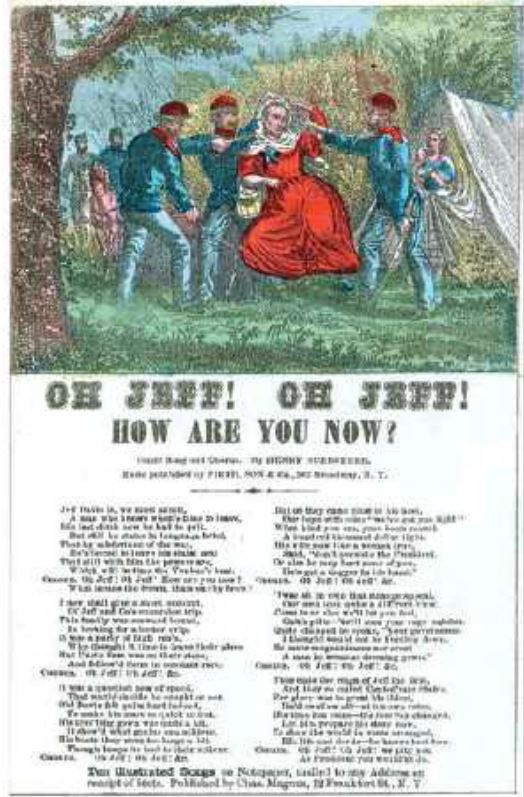
Regardless of whether or not you agree with Grant's point of view, the choices of subjects to commemorate with postal issues are no less political than the decisions about whose likenesses should be celebrated in public parks, and both choices ought to be judged according to the same praiseworthy principles.
Dedication to Stephen G. Esrati -
Many Linn's readers will surely disagree with my opinions about the Stone Mountain stamp, the subject of this month's Spotlight, just as many of us once took issue with controversial views expressed by Stephen G. Esrati in his 1980s "Stamps and Politics," a Linn's feature that was one of my favorite columns. I dedicate this Spotlight column to him on the occasion of his 89th birth anniversary March 13.
Esrati was born in Berlin, Germany. His family emigrated to Palestine in 1933, and came to the United States in 1937. He became an American citizen in 1944. He served in the U.S. Army in Italy after World War II and in the Irgun Zvai Leumi underground Jewish army in Palestine.
After earning two political science degrees from Boston University, Esrati became a journalist. He worked on the Boston Herald-Traveler, the Celina (Ohio) Daily Standard, the Van Wert (Ohio) Times-Bulletin, and the Toronto (Ont.) Globe and Mail.
At the time of his retirement, he was a copy editor for the Cleveland Plain Dealer. He has written two novels, Comrades, Avenge Us, set in the Balkans during World War II, and The Tenth Prayer, critical of Israel.
[Ken Lawrence is a lifelong socialist, originally from Chicago, who was an activist in Mississippi for more than 20 years. He co-founded the Deep South Peoples History Project in 1973. Today he lives in Pennsylvania and writes feature articles and columns about stamps and stamp collecting.]
Thanks to the author for sending this to Portside.

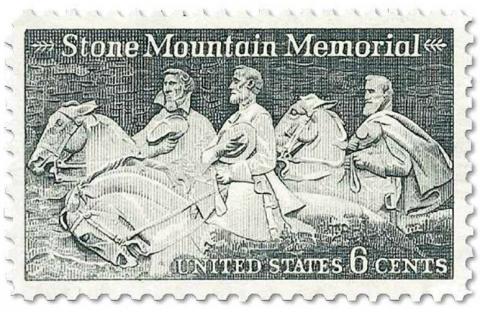
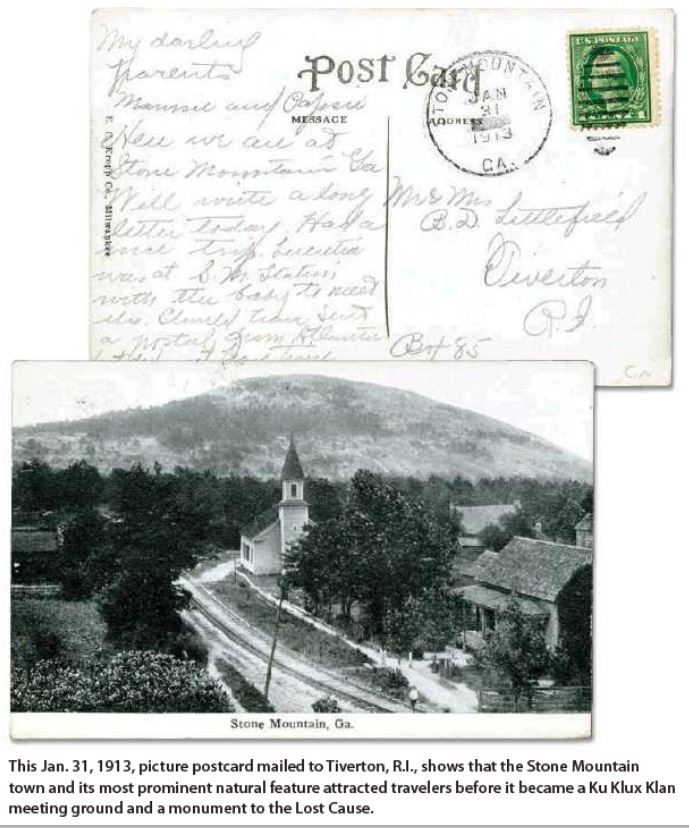
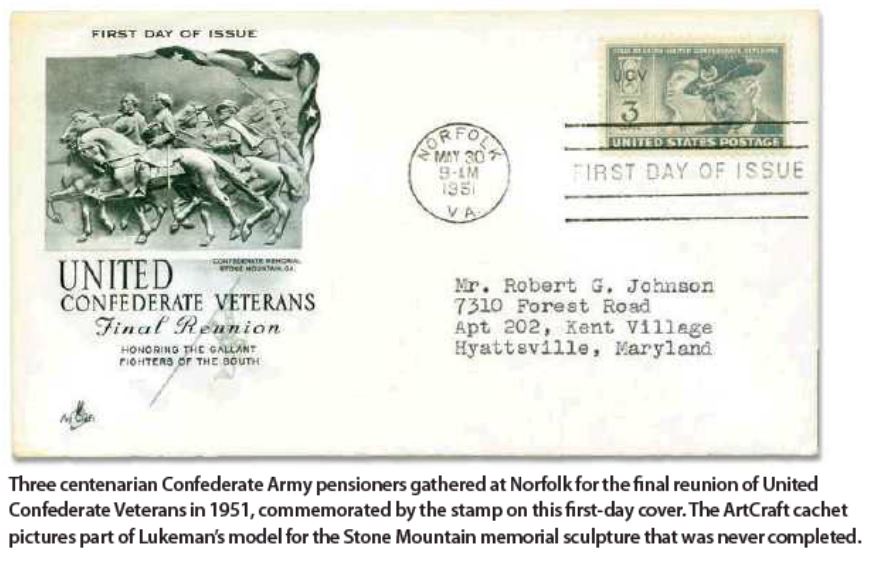
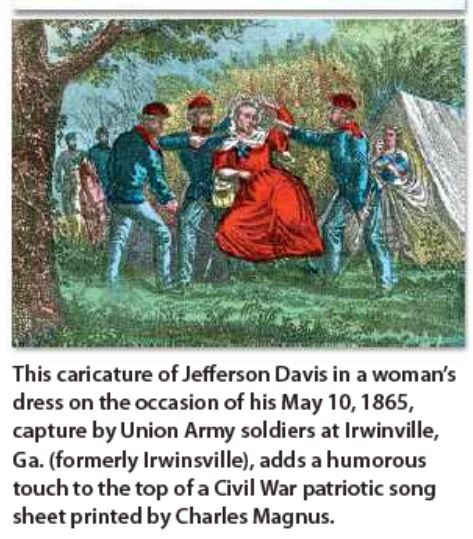
Spread the word